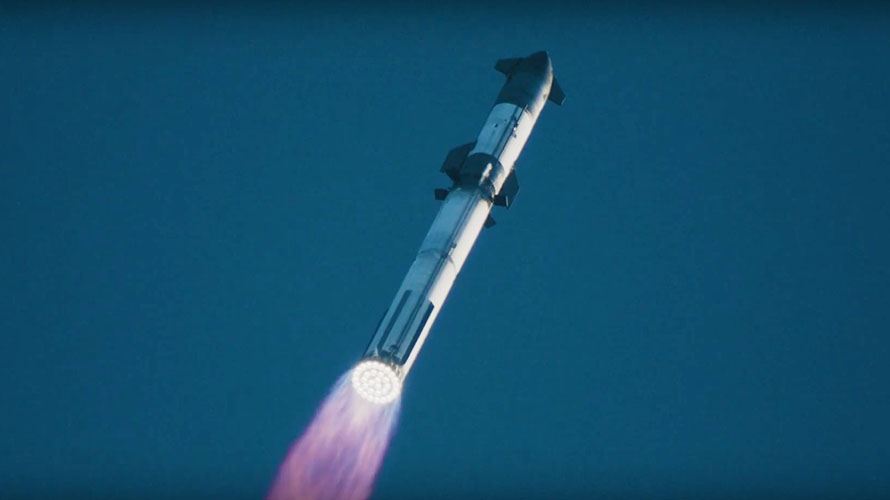Image: Starship/Superheavy second flight test courtesy SpaceX.
By Dale Skran, NSS Chief Operating Officer

With two wars going on and a U.S. presidential election looming, you may have missed some amazing progress in terms of access to space. SpaceX set new records aplenty in 2022, but 2023 exceeds them all by a large margin. Let us take a look at the most significant SpaceX achievements for 2023 that involved the Falcon program:
- 96 Falcon 9/Falcon Heavy flights vs 61 last year.
- 1,985 Starlink satellites launched on 63 flights, more than the entire 2022 flight total for all F9 launches.
- Cumulatively to date, SpaceX has reflown boosters 216 times and landed boosters 241 times.
- The Dragon 2 crew capsule Endeavour flew for the fourth time, a new record.
- One first stage has flown 19 times [nineteen!!!] and others have flown 17 times.
- A perfect flight record – no loss of missions all year.
- A rapidly increasing flight cadence, with a record ten flights in November.
There were three SpaceX crewed flights in 2023, including:
- Crew 6 to the ISS on 3/2/2023
- Axiom AX-2 to the ISS on 5/21/2023
- Crew 7 to the ISS on 8/26/2023
The transporter rideshare program continued to be a big hit, with four flights in 2023, including:
- Transporter 6 on 1/3/2023
- Transporter 7 on 4/14/2023
- Transporter 8 on 6/12/2023
- Transporter 9 on 11/11/2023
There were five Falcon Heavy flights including:
- USSF-67 on 1/9/2023
- ViaSat 3 Americas on 4/30/2023
- Jupiter-3 (Echostar 24) on 7/29/2023
- Psyche on 10/13/2023
- USSF-53 (X-37B) on 12/23/2023
For some context, here are some 2023 statistics:
- There were 107 total U.S. launches, so SpaceX alone was responsible for 92% of the U.S. total, up from 78% in 2022.
- China had 62 launches, only one more than in 2022, so SpaceX by itself launched significantly more than China by itself.
- Russia launched only 19 times, so SpaceX launched over 5x times as often as Russia.
- Europe launched only 3 times, so SpaceX launched 32x as often as Europe.
- ULA launched 3 times in 2022, so SpaceX launched more than 32x as often as ULA did.
This is what increasing domination of the world launch market looks like. Due to delays in the development of the Vulcan, New Glenn, Ariane-6, and other rockets, payloads are frequently shifting over to the SpaceX column. Additionally, the success of the transporter rideshare series has taken a big bite out of the small launch providers. Unlike past years, in which the Falcon Heavy struggled to find payloads that required its large capacity, 2023 saw five Falcon Heavys leap skyward. Two of the most important missions were the NASA Psyche probe to a metal asteroid and the USSF launch of the mysterious X-37B to a higher than ever orbit.
At some point the Vulan, New Glenn, and Ariane-6 rockets will be flying routinely, and we can expect a degree of shrinkage in the out-year SpaceX manifest. However, I would not be surprised to see SpaceX continue to lead the world with Falcon 9 launches with steadily increasing metrics for at least one, and probably two more years.
Overall, the SpaceX 2024 manifest is stuffed, with SpaceX projecting 144 launches. After reaching 96 Falcon 9s plus 2 Starships totaling 98 in 2023, 144 doesn’t seem that difficult for SpaceX to achieve.
Looking into 2024 in more detail, some of the big events planned include:
- Three Falcon Heavy flights, including the Griffin/VIPER Moon flight and an October launch of the Europa Clipper for NASA.
- Axiom AX-3 on January 17.
- NASA Crew-8 in February 2024.
- Transporters 10, 11, and 12.
- Intuitive Machines IM-1, a lunar lander in February 2024 (delayed from 2023).
- Polaris Dawn – the first of three crewed Polaris Dawn flights captained by adventurer Jared Isaacman. This one will test the new SpaceX EVA suits (delayed from 2023).
- Firefly Blue Ghost, a lunar lander.
- Intuitive Machines IM-2, another lunar lander.
- Axiom AX-4 (crewed).
- NASA Crew-9 in August, 2024.
- Cygnus NG-22 [flying on the F9 while Northup Grumman re-engines the Antares launch vehicle].
A lot of ink has been dropped on Starship/SuperHeavy, which had its first two “full stack” test flights in 2023. Neither one counted as fully successful, and the first mostly demonstrated that a rocket that big really needs a deluge system or flame diverter. A giant upside-down shower head was added to the launch pad, and the second flight enjoyed a much great degree of success than the first, with apparently all 33 Raptor engines in the first stage making it to stage separation. Very importantly, so-called “hot staging” was successfully demonstrated with Starship for the first time. Unfortunately, as the first stage began the “flip” maneuver to return, a RUD occurred. Although second stage made it far out over the Atlantic, near the point where the engines were going to be turned off, the vehicle went off course and the flight termination system engaged.
For SpaceX, 2023 was a big success. One minor glitch came when the booster that had just flown its 19th flight tipped over while at sea due to heavy winds. However, the engines were recovered, and will be analyzed to understand wear and tear better. Various environmental groups have filed lawsuits against the FAA alleging that the Starship/Superheavy launches endanger the environment, but so far these efforts do not appear to have slowed SpaceX down. NASA has raised concerns about the pace of Starship development and the number of tanker flights Starship may need to reach the Moon, but 2025 was always an unrealistic date for Artemis, so expect a delay to 2026 or 2027 for the first landing. Perhaps the biggest setback for SpaceX in 2023 came in December when the FCC stripped SpaceX of $886 million over 10 years to deliver high-speed broadband to underserved groups. Given that Starlink has over 2 million customers already, the loss of this contract does not appear to threaten SpaceX strongly, but a loss is still a loss.
The hardware for the third Starship/SuperHeavy test flight has already been put through static fire tests, so most observers expect the FAA to approve this flight sometime in first quarter 2024. With a high degree of probability, we will see at least a 4th Starship test in 2024, and more with increasing levels of success. A lot rides on the success of Starship, with many observers claiming that SpaceX needs Starship/Superheavy to deliver higher capacity Starlink satellites to keep service levels high as the customer base grows. Regardless of exactly what happens in 2024 with SpaceX, excitement is guaranteed!!




















2 thoughts on “SpaceX 2023 End of Year Roundup”
A truly excellent end-of-year space roundup — with a sketch of events for 2024 to boot! Thanks so much, Dale.
SpaceX makes NASA’s human human spaceflights efforts seem inadequate. And NASA is continuing to support Boeing’s SLS effort. It feels so good to this space cadet to see movement on the space frontier. Thanks for pointing out what a good space program can do.
I watch Starbase live at https://www.youtube.com/watch?v=mhJRzQsLZGg to watch the progress of the big rocket with 33 engines, the Starship/SuperHeavy.
Somerset Meece, scifi author at allenmeece.com